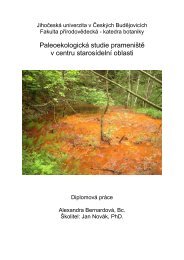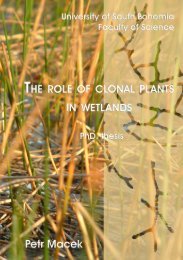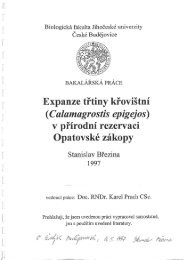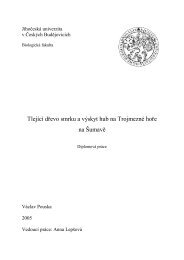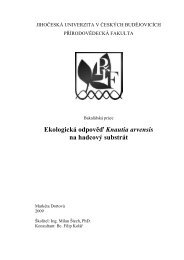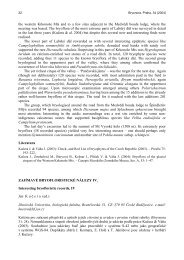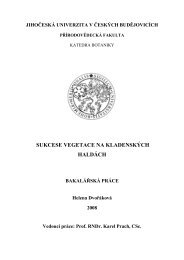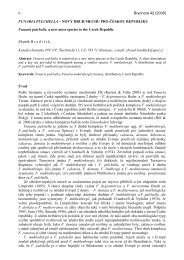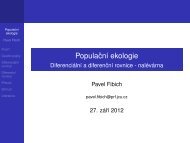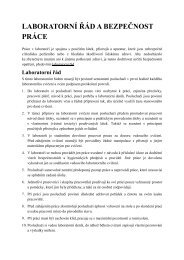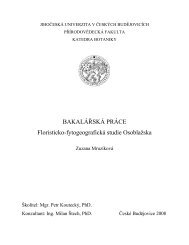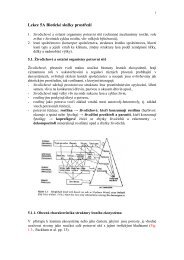NOVÁ LICHENOLOGICKÁ LITERATURA XXI. New lichenological ...
NOVÁ LICHENOLOGICKÁ LITERATURA XXI. New lichenological ...
NOVÁ LICHENOLOGICKÁ LITERATURA XXI. New lichenological ...
Create successful ePaper yourself
Turn your PDF publications into a flip-book with our unique Google optimized e-Paper software.
52 Bryonora 51 (2013)<br />
Hodkinson B. P., Gottel N. R., Schadt C. W. & Lutzoni F. (2012): Photoautotrophic symbiont<br />
and geography are major factors affecting highly structured and diverse bacterial<br />
communities in the lichen microbiome. – Environmental Microbiology 14: 147–161.<br />
Hodkinson B. P. & Lendemer J. C. (2012): Phylogeny and taxonomy of an enigmatic sterile<br />
lichen. – Systematic Botany 37: 835–844.<br />
Holien H. & Tønsberg T. (2012): Biatora kodiakensis confirmed from Europe. – Graphis<br />
Scripta 24: 49–52.<br />
Honegger R. (2012): The symbiotic phenotype of lichen-forming ascomycetes and their endoand<br />
epibionts. – In: Hock B. [ed.], Fungal Associations, Mycota IX, p. 287–339, Springer-<br />
Verlag, Berlin, Heidelberg.<br />
Huang X., Xue J. & Guo S. (2012): Long chain n-alkanes and their carbon isotopes in lichen<br />
species from western Hubei Province: implication for geological records. – Frontiers of<br />
Earth Science 6: 95–100.<br />
Jablońska A. (2012): Porosty z rodzaju Porpidia Körb. występujące w Polsce. The lichen<br />
genus Porpidia Körb. in Poland. – Monographiae Botanicae 102: 5–123.<br />
Jeschke M. (2012): Cryptogams in calcareous grassland restoration: perspectives for artificial<br />
vs. natural colonization. – Tuexenia 32: 269–279.<br />
Johansson O., Palmqvist K. & Olofsson J. (2012): Nitrogen deposition drives lichen<br />
community changes through differential species responses. – Global Change Biology 18:<br />
2626–2635.<br />
John V. & Haedeke J. (2012): Neufund von Multiclavula mucida in Rheinland-Pfalz mit<br />
Bemerkungen zur Verbreitung und Gefährdung der Art. – Herzogia 25: 287–292.<br />
Jones T. C., Green T. G. A., Hogg I. D. & Wilkins R. J. (2012): Isolation and characterization<br />
of microsatellites in the lichen Buellia frigida (Physciaceae), an Antarctic endemic. –<br />
American Journal of Botany 99: e131–e133.<br />
Junttila S. & Rudd S. (2012): Characterization of a transcriptome from a non-model organism,<br />
Cladonia rangiferina, the grey reindeer lichen, using high-throughput next generation<br />
sequencing and EST sequence data. – BMC Genomics 13: 575.<br />
Jüriado I., Karu L. & Liira J. (2012): Habitat conditions and host tree properties affect the<br />
occurrence, abundance and fertility of the endangered lichen Lobaria pulmonaria in wooded<br />
meadows of Estonia. – Lichenologist 44: 263–276.<br />
Kantvilas G. & Lumbsch H. T. (2012): Reappraisal of the genera of Megalosporaceae<br />
(Teloschistales, Ascomycota). – Australian Systematic Botany 25: 210–216.<br />
Kärnefelt I., Scholz P., Seaward M. R. D. & Thell A. (2012): Lichenology in Germany: past,<br />
present and future. – Schlechtendalia 23: 1–90.<br />
Ketner-Oostra R., Aptroot A., Jungerius P. D. & Sýkora K. V. (2012): Vegetation succession<br />
and habitat restoration in Dutch lichen-rich inland drift sands. – Tuexenia 32: 245–268.<br />
Kim J. A., Hong S. G., Cheong Y. H., Koh Y. J. & Hur J.-S. (2012): A new reducing<br />
polyketide synthase gene from the lichen-forming fungus Cladonia metacorallifera. –<br />
Mycologia 104: 362–370.<br />
Kirschbaum U., Cezanne R., Eichler M., Hanewald K. & Windisch U. (2012): Long-term<br />
monitoring of environmental change in German towns through the use of lichens as<br />
biological indicators: comparison between the surveys of 1970, 1980, 1985, 1995, 2005 and<br />
2010 in Wetzlar and Giessen. – Environmental Sciences Europe 24: 19.<br />
Kononenko C. P., Burkin A. A. & Tolpysheva T. Yu. (2012): Enzyme immunoassay of the<br />
secondary metabolites of micromycetes as components of lichen substances. – Applied<br />
Biochemistry and Microbiology 48: 71–76.



